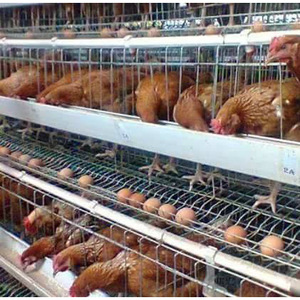Introduction of chicken laying cage
- font size
- Be the first to comment!
When using layer chicken cages to raise layer hens, chickens are generally put into the cage from 8 weeks of age, and are eliminated from the cage until the 72 weeks of age have completed a production cycle. Therefore, under the good environmental conditions of the chicken house, it is also necessary to have a reasonable structure of the chicken cage to enable the laying hens to exert their highest production efficiency.
The size of the layer cage must be able to meet its certain activity area, feeding position and height. At the same time, in order to make the laid eggs roll out of the cage in time, the cage bottom should have a certain inclination. According to the above requirements, the arrangement of layer cages must be composed of many small single cages. There are several ways to raise 3 or 4 animals in each small cage, and there are several ways to raise 6 or 8 animals.
The size of the single cage of a layer cage is generally 380-450 mm in front height, 300 mm in rear height, 9-10 degrees in the bottom of the cage, 350-600 mm deep in the cage, and the egg collecting trough outside the cage is 120- 160 mm. The width of the cage depends on the feeding position. The feeding position of each chicken is 100-110 mm.

There are two forms of manufacturing and installation of single cages, namely, integral and assembled. The integral type is to form a single cage of several units into a whole. It is characterized by easy installation, but consumes materials, is difficult to handle and is easy to deform after being made. The assembly type adopts an integral cage frame, and there are two forms of manufacture and installation of the single cage, namely the integral type and the assembly type. The integral type is to form a single cage of several units into a whole. It is characterized by easy installation, but consumes materials, is difficult to handle and is easy to deform after being made. Assembled type is to use the overall cage frame. After the overall cage frame is installed, hang the cage nets and serve. It is characterized by neat installation, easy replacement and maintenance. The assembly type is more common in actual production.
Each fan cage net of a single cage is generally made by spot welding of cold drawn steel wire, but the function of each fan cage net is different, and their material thickness and mesh size have different requirements.
The width of the cage door of the poultry layer breeding cage is determined by the width of the single cage. Generally, a vertical fence is welded with a 3 mm diameter metal wire, with a spacing of 50-60 mm. The cage door is 400 mm high, and its lower edge should be 50-55 mm away from the bottom net to leave the egg-going space; or an egg guard 50 mm away from the lower edge can be placed in the cage to prevent the egg trap from being trapped. Eggs are pecked by chickens, and chicken manure leaks into troughs and sinks.


